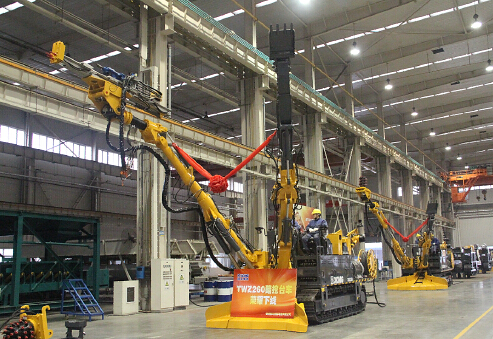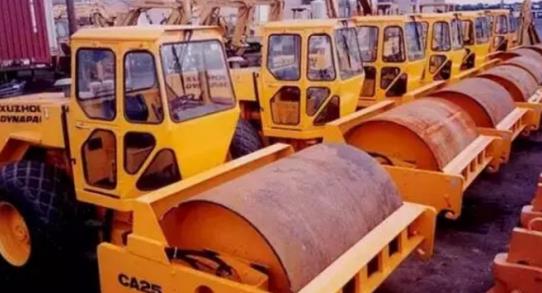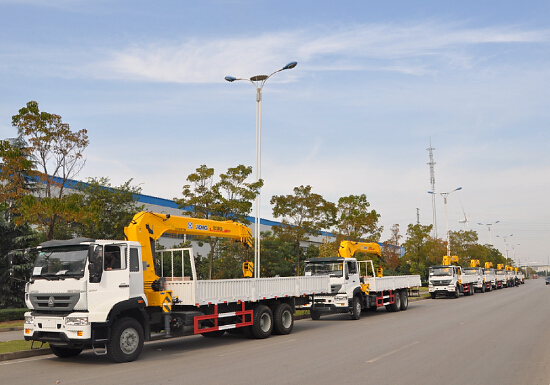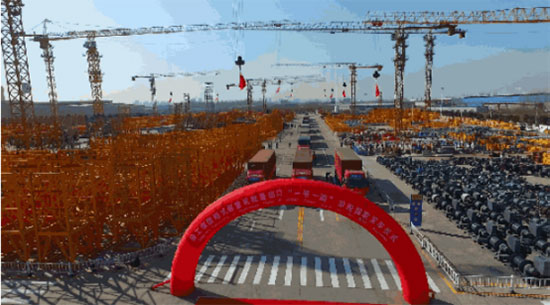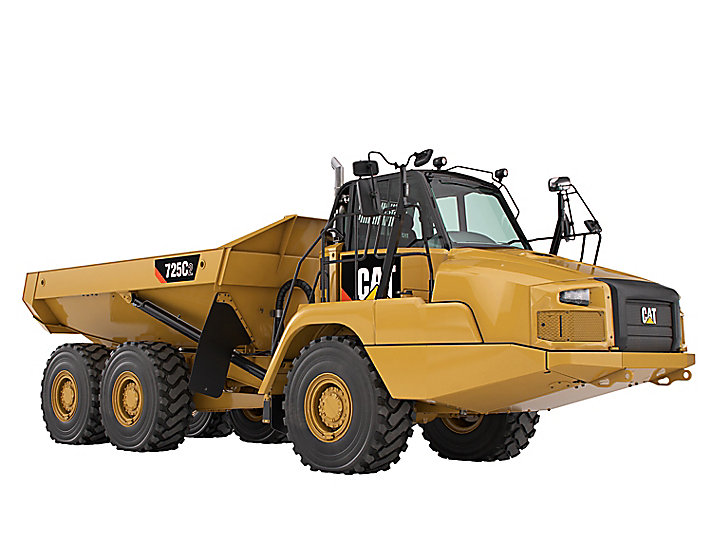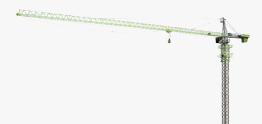

Contact Information:
Terex Cranes Global Marketing
Press & Public Relations
E-mail: info.cranes@terex.com
terex forever linked to shuttle history
Terex® CC2800-1 Specified as the Primary Crane for Discovery and Enterprise Picks
Washington, USA, June, 6th, 2012 – For the Space Shuttle Discovery, it was a journey of nearly 150 million miles that ended at Washington Dulles International Airport. Discovery’s maiden voyage was made on August 30, 1984, and it flew 39 successful missions into space over its 27-plus years of service. It was the most traveled and storied of all the space shuttles in NASA’s fleet.
On April 17, 2012 Discovery made its final voyage atop its Boeing 747 Shuttle Aircraft Carrier (SAC) with much fanfare from onlookers and local, national and international media. Reports focused on its final flight and place in space exploration history.
Battled and scorched from dozens of space missions, Discovery replaced the pristine Space Shuttle Enterprise at the Smithsonian Institution’s James S. McDonnell Space Hangar at the Steven F. Udvar-Hazy Center. Before being towed from Dulles to its final exhibit place, Discovery had to be hoisted from its carrier and its landing gear lowered into place one final time.
How is the shuttle removed from its 747 SAC perch when it’s not at a space center? That is where the mainstream media’s coverage and fanfare ends, and the work for South Kearny, N.J.-based J. F. Lomma, Inc. and the Terex® CC 2800-1 crawler crane begins.
Historic Picks
Under the cover of night in the late evening hours of April 19, 2012 and slipping into the early morning hours of April 20, Lomma and the United Space Alliance work crews methodically hoisted the 196,400 (89,085 kg) shuttle off of the 747 SAC. “You cannot describe what it’s like to be part of space shuttle history,” says Frank Signorelli, crane and rigging manager for J. F. Lomma, Inc. Josh Barnett, field service representative for Terex Cranes, who was on site to support Lomma on the lift, added, “It was a one-of-a-kind experience.”
Serving the New Jersey and New York area as well as markets from coast to coast and select international markets, Lomma has seen its share of historic work. This includes supplying crane and rigging services for construction work that continues today at the World Trade Center.
For Lomma, planning for this job started nearly two years ago when company officials first considered bidding for the job. NASA was very specific in what equipment was required for the work. “The bid called specifically for the Terex CC 2800-1 as the primary crane to do the pick as well as all of the other supporting cranes and equipment,” says Signorelli.
Part of the reason for this lies with NASA’s experience with this crane model for a similar pick decades ago. When the 747 SAC transports the space shuttle to a place other than a space center, there is a need for crane and rigging equipment. “These picks do not happen often, since NASA already has a shuttle removal method in place at each space center,” explains Barnett.
In the early 1990s, NASA had the rare need to hoist a shuttle from the 747 SAC, and a Terex legacy brand was selected for the job. “A Demag 2800 crawler crane was used in that project as the primary crane,” mentions Jim Creek, Terex Cranes’ senior product manager for crawler cranes – North America. “NASA has a history of successful lifts with this crane.”
Staples of the Terex crawler crane line, the CC2800-1 and its predecessor, the CC 2800, have worked on jobsites throughout the world for more than 20 years. The CC 2800-1 offers a 660-ton (600-tonne) capacity at a 32.8-ft (10-m) radius, more than enough to handle Discovery’s weight.
It features a maximum 196.9-ft (60-m) main boom length and a variable 100-ft (30.5-m) radius Superlift attachment to boost lift capacities. “Superlift offers an additional 4,000 to 600,000 lb (1,814 to 272,155 kg) of counterweight on the tray, which enables the crane to lift more weight further from the crane’s base,” says Creek.
Having the right experience and all the necessary equipment to complete the job, Lomma was awarded the shuttle project. It consisted of not one but two shuttle hoists. The first lifted the Space Shuttle Discovery off of the 747 SAC for the shuttle’s eventual spot at the Smithsonian. The second loaded the Space Shuttle Enterprise onto the carrier, so it could be flown to John F. Kennedy International Airport in New York.
It took Lomma nearly three months to prepare for and arrange the pick. “We had conference calls with NASA two times a week,” says Signorelli. “Communication was often and thorough between our company and NASA.”
Lomma purchased the CC 2800-1 ultimately used for the pick about two years ago. It was on rent with a customer in Quebec. Upon returning to the yard, the crane was rigged to make sure the right components were in place for the job. “We ran the crane in our yard,” says Signorelli. “The (IC-1) computer screen is extremely user friendly and self-explanatory. It’s not a complicated crane to operate.”
Upon completing the dry run at the yard, Lomma disassembled the crane and sent the components to the jobsite. Lomma’s crews spent three days at Dulles rigging the CC 2800-1 and a fourth day running through test lifts to make sure everything would go smoothly.
Safety and Precision
When it came time for the shuttle pick, there was very little left to question. “NASA had everything marked out on the ground – positioning for the Terex crane, the supporting crane and the 747,” explains Signorelli.
The CC 2800-1 crawler crane was equipped with a 177-ft (53.9-m) main boom and a 98-ft (29.9-m) Superlift mast. Lomma used 352,000 lb (159,665 kg) of main counterweight with no central ballasts. Superlift counterweight of 275,000 lb (124,738 kg) was added to the tray 50 ft (15.2 m) from the crane base. “Normally, a lift like this would require only 220,000 lb (99,790 kg) on the Superlift, but NASA’s additional safety factor required an extra 55,000 lb (24,948 kg) on the tray,” explains Barnett.
The additional safety requirement stemmed from the need for workers to be under the live load while unhooking the shuttle from its 747 SAC. “NASA required a 75% derate from the crane’s standard 85% chart, which is a big safety factor,” mentions Signorelli.
In the overnight hours, when airport activities were at a lull and winds were calm, Lomma and United Space Alliance crews began the removal of the shuttle. The 747 SAC, supporting crane lifting the front of the shuttle and CC 2800-1 lifting the heavier back end were all positioned according to NASA’s layout.
NASA engineers used calculations from the CC 2800-1’s IC-1 controls to map out the final position of the crane. “They wanted the connection between the shuttle and our crane to be at 112 ft (34.1 m),” says Barnett, “and the actual distance in the field from the center of the crane to the hook was 111.9 ft (34.1 m). They were impressed with IC-1’s accuracy.”
Slowly and with precision the pick began with the weight shifting and then transferring to the cranes as the brackets were removed from the shuttle and carrier. After the shuttle hovered a safe distance over the carrier, a pushback tug backed it from underneath the shuttle. The shuttle was then lowered to within a few feet of the ground. Auxiliary hydraulic power lowered the shuttle’s landing gear for a final time before the cranes lowered it to the ground.
“The subtle movements offered by the CC 2800-1’s hydraulic system definitely helped with this pick,” says Barnett. “If the crews only needed 0.5 inch (12.7 mm) of movement, the crane was able to give it to them.”
A few days later, Discovery was towed to the Smithsonian and replaced the Space Shuttle Enterprise, which had been on display inside the James S. McDonnell Space Hangar since 2003. This prompted a second pick and final move of the Enterprise to its new home in New York.
Enterprise on the Hudson
Within a week after the Discovery pick, Lomma’s crews were back at Dulles, this time to reverse the process and load Enterprise on the 747 SAC. With one hoist project already completed, the second pick of the Enterprise went equally as smooth as the Discovery effort. “Enterprise was actually much lighter than Discovery, so we had no issues,” says Signorelli.
A lesser known, but vital link to the shuttle program, Enterprise never made a trip to outer space. It was constructed in the mid-1970s as a prototype tester for what became the final space shuttle design. NASA engineers ran it through a number of flight and landing test simulations to prove the validity of the concept. While NASA initially intended to retrofit Enterprise for space travel, several final shuttle design changes kept it grounded.
Enterprise, via the 747 SAC, took off from Dulles on April 27 for its final home in New York City and landed at JFK International Airport. At the same time, the CC 2800-1 crane components were derigged and loaded onto trucks and trailers heading for New York. Once arriving at JFK, the crane equipment was rigged, tested and ready for another shuttle pick.
Originally scheduled for the morning hours of Monday, May 14, the Enterprise pick was moved up due to inclement weather. “Projected wind speeds were predicted to approach NASA’s 10 mph (16 kmph), which was the wind speed limit for removing the shuttle from its carrier,” mentions Signorelli.
Even though the CC 2800-1’s configuration for the Enterprise pick was rated for a maximum wind speed of 25 mph (40 kmph), NASA’s tighter wind threshold was followed. “Therefore, they moved the pick up two days to start on Saturday, May 12,” he adds.
Under clear weather conditions and wind speeds flirting with NASA’s threshold, Lomma began the pick just before midnight. Similar with the Discovery project at Dulles, careful planning and constant communication allowed the pick to be completed successfully.
By 7 a.m. EDT Sunday, May 13, Enterprise was loaded onto a special wheeled transport and moved into a hangar at JFK. It embarked on a three-day journey on the Hudson River in early June. Its final destination is the Intrepid Sea, Air and Space Museum in New York City.
“It’s indescribable to be a part of history,” comments Signorelli. “This is something I was able to take my kids to see, and a story they will tell their children.”
About the Terex® CC 2800-1 Crawler Crane
The versatility of Terex® crawler cranes begins with a broad range of available models, including lattice boom crawler cranes like the CC 2800-1, lattice boom truck cranes, narrow track carriers and pedestal cranes. A modular design delivers the flexibility to adapt the crane for specific project requirements.
The CC 2800-1 offers a maximum 660-ton (600-tonne) lift capacity at a 32.8-ft (10-m) radius and excellent lifting capacities throughout its entire working range. Its variable Superlift radius increases lifting capacities at further distances away from the crane’s base. A variety of boom configurations, including extensions, luffing jib, windmill kit, vessel lift, as well as many other modules are available to increase crane versatility.
Transportability is improved due to the CC 2800-1’s unique open-boom design. These rectangular sections do not sit as high on the trailer as competitive boom designs, and no internal cross bracing allows smaller boom sections to be nested inside of larger sections to reduce the number of trailers required for transport. The CC 2800-1 can be equipped with the exclusive Terex® Fall Protection System, winner of the 2012 ESTA Safety award, which advances safety when rigging boom sections.
Its innovative IC-1 crane control system features a touchscreen with intuitive pictorial displays for operating ease. The crane’s Quadro-Drive on-demand system improves operating stability and allows the base to move and spin under load, increasing on-site versatility.
About J. F. Lomma, Inc.
James Lomma started J. F. Lomma, Inc. in 1975 with one truck and trailer and a vision for a company far beyond that of a single truck driver. Over the years, he moved into the sales arena and expanded trucking operations to include specialized transportation for large and over dimensional pieces, ranging from heavy equipment to airplanes. Further expansion led to a rigging department to unload and assemble the pieces of equipment that the company transported. The purchase of a crane company in 1996 expanded J. F. Lomma’s services to include lifting as well as transportation and rigging.
Today, J. F. Lomma is the premier provider of cranes, heavy hauling, rigging and transport services in the Northeast. With a fleet exceeding 355 cranes and growing, the company offers lifting services for virtually every need and is one of the most prominent crane-rental houses on the East Coast. It serves an expanding customer base throughout the United States as well as contractors in Canada and the Caribbean.
While substantially growing over the years to offer more services reaching a broader customer base, James Lomma has never forgotten his roots, and the company offers personalized service for all of its customers. “Mr. Lomma has a heart for the industry, his customers, the company and all the employees,” says Signorelli, a 24-year employee of J. F. Lomma. “His approach is the reason why we are so successful.”
J. F. Lomma, Inc. can be contacted at 973-589-2000 or info@jflommainc.com.
About Terex
Terex Corporation is a diversified global manufacturer of a broad range of equipment that is focused on delivering reliable, customer-driven solutions for many applications, including the construction, infrastructure, quarrying, mining, shipping, transportation, refining, energy, utility and manufacturing industries. Terex reports in five business segments: Aerial Work Platforms; Construction; Cranes; Material Handling & Port Solutions; and Materials Processing. Terex offers financial products and services to assist in the acquisition of equipment through Terex Financial Services. More information can be found at www.terex.com.













